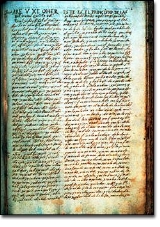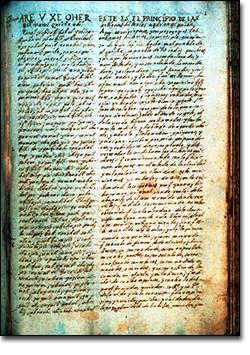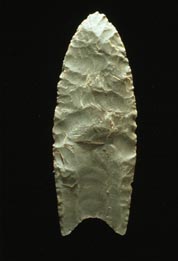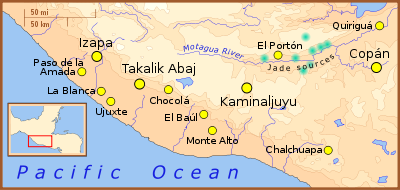
Museo Popol Vuh
Encyclopedia
The Museo Popol Vuh is home to one of the major collections of Maya civilization
art in the world. It is located on the campus of the Universidad Francisco Marroquin
in Zone 10, Guatemala City
and is known for its extensive collection of pre-Columbian
and colonial art of the Mayan culture.
The Popol Vuh Museum is a private, nonprofit, scientific institution supported by its own funds and external donations. The museum is operated by a Board of Directors of citizens of Guatemala
interested in the preservation and public display of the exhibits. One of its missions is to provide an educational focus for people who want to see and learn about the pre-Columbian past of Guatemala with the preservation, research, and diffusion of information .
Although the museum is well known for its funerary ceramic art
, the collection includes a variety of portable stone sculptures, especially from the Preclassic period, and from the coast and adjacent highlands. The section on Maya pottery includes some of the best preserved Maya vases and bowls .
 The origin of the museum dates back to 1975, when Mr.Jorge Castillo hired maro tejada a student of archaeology at la Universidad del Valle, to classify his extensive collection.after it was classified and set up for display in cronological order and it was opened up to the public in zone 1. after Mr.Castillo died in 1977, his decided to donate the collection to Universidad Francisco Marroquín.The museum was created originally in 1977 to house the collection of Mr. and Mrs. Castillo and now forms part of a beautiful architectural complex of the Universidad Francisco Marroquín
The origin of the museum dates back to 1975, when Mr.Jorge Castillo hired maro tejada a student of archaeology at la Universidad del Valle, to classify his extensive collection.after it was classified and set up for display in cronological order and it was opened up to the public in zone 1. after Mr.Castillo died in 1977, his decided to donate the collection to Universidad Francisco Marroquín.The museum was created originally in 1977 to house the collection of Mr. and Mrs. Castillo and now forms part of a beautiful architectural complex of the Universidad Francisco Marroquín
in Guatemala City. Jorge and Ella Castillo donated most of their collection of archaeological and colonial pieces in 1978 which are the basis of the Popol Vuh Museum today. They began their private collection of archeological and colonial objects years before they established founding in 1977. The first location was in La Reforma Ave and 16th street, Guatemala City
, but later moved to the Galerias Reforma building in Zone 9 in Guatemala City after three years. Sixteen years later, it was moved to Zone 10, where it stands today.
The museum is named after the Popol Vuh
, a book written soon after the Spanish conquest of Guatemala
. It narrates myths and pre-Columbian
history of the Quiche, whose kings dominated great part of the Western plateau of Guatemala . The collection at the Popol Vuh Museum includes many objects related to the narratives of the Popol Vuh
book.
in terms of physical facilities. It has a very geometric architectural style opposed to the Mayan ruins and renaissance
styles erected by the Spanish in Guatemala City
. The museum has its preservations behind clear walls with advanced technology of display. The inside walls maintain neutral colors to keep focus on the artifacts.
The Popol Vuh Museum is located on the campus of Universidad Francisco Marroquin
in Zone 10 of Guatemala City. It is open Monday through Friday from nine to five, Saturday from nine to one and is closed on Sunday. Wheelchair accessibility is available in the facility. There are no bus routes available to the museum. Transportation includes walking downhill from Sexta Avenida or yellow cab service .
The museum offers guided tours of each gallery along with workshops such as archaeological excavation, restoration activities, Mayan pottery creation, etc. Presentations, lectures, and courses are organized throughout the year to educate the community of the Mayan culture in the Guatemalan heritage.
 The exhibit galleries are organized chronologically beginning with the Paleoindian, Archaic, Preclassic, Early Classic, Late Classic, and Postclassic periods of the ancient Maya and ending with Colonial Art . More than 400 archaeological and colonial treasures are on display.
The exhibit galleries are organized chronologically beginning with the Paleoindian, Archaic, Preclassic, Early Classic, Late Classic, and Postclassic periods of the ancient Maya and ending with Colonial Art . More than 400 archaeological and colonial treasures are on display.
Paleoindian (15,000 – 9000 BC):
The oldest object in the Museum, which dates back to 9000 BC, is a clovis point
, used as a sharp stone tool. It was found in Nahuala
in Guatemala’s western highlands and is one of the few found in the country. The Paleoindian period is characterized by hunter-gatherer groups who entered the America by crossing a land bridge connecting eastern Siberia and Alaska .
Archaic (9000 – 1500 BC):
Most of the art found from the Archaic period was excavated from the central highlands and eastern pacific coast and includes many styles of ceramics, in specific, pottery. The Archaic period is recognized as the second period of human existence in the Americas and the shift from agriculture to sedimentary farming. Political organizations of chiefs and caciques and permanent agricultural settlements had been established by the end of this era . This civil structure influenced artists and what was painted on surface drawings on pottery art.
 Preclassic (1500 BC – 250 AD):
Preclassic (1500 BC – 250 AD):
Popular material found in artifacts during the Preclassic period involves ceramic, jade, and stone, much of which was traded with the Olmecs in the southern coast. The most notable site where most ojects were found is the Kaminaljuyu
in the valley of Guatemala, which became popular for its irrigation canal system and its great buildings . The scale of their development reflected the status, power, and wealth of the chiefs of Kaminaljuyu
. Many of the oldest examples of hieroglyphic texts are from Guatemala from this rich site. Exhibits from this era include ceramics from the Middle and Late Preclassic era from the Kaminaljuyu and southern coast .
 Early Classic (250 – 600):
Early Classic (250 – 600):
During this period, ieroglyphext was adopted as the main form of communication and art and multi-colored ceramics emerged as a popular element of Classic Maya art . Exhibits include polychrome ceramics from this period . Influence from the large city of Teotihuacan
in central Mexico is evident in ceramic art
with incense burner and cylindrical tripods of decorative styles . The largest area of the permanent exhibit at the Popol Vuh Museum is dedicated to the Classic period .
Late Classic (600 -900):
This period is known for the greatest exponential growth of population in the northern lowlands . The Mayan hieroglyphic texts excavated from this region were advanced, indicating a great level of complex interaction between cities and their political leaders. Exhibits include painted ceramic art
of several regional styles depicting mythology, religion with god like figures containing hieroglyphic texts, and often indicating the owner of the piece and the artist .
Postclassic (900 – 1,500):
This era is registered as the collapse of the Maya civilization
after the Spanish conquest. During this time, much of the population in the highlands and southern coast sough change with the use and trade of gold and copper. Exhibits in the museum from this era include plumbate pottery which has orange and grey tones and depicted lives of animals and supernatural entities of their surfaces. Such pottery was greatly influenced by Mexican culture and was widely traded throughout the Mesoamerica
until the end of the Early Postclassic period .
Colonial Period (1500 - 19th century):
The colonial period was marked by a rigidly stratified society. During the Colonial period in Guatemala
, artistic forms were predominantly educational and religious . Guatemalan sculptures of the sixteenth through eighteenth centuries include examples of Renaissance
, Baroque
, and Neoclassic styles .
Maya civilization
The Maya is a Mesoamerican civilization, noted for the only known fully developed written language of the pre-Columbian Americas, as well as for its art, architecture, and mathematical and astronomical systems. Initially established during the Pre-Classic period The Maya is a Mesoamerican...
art in the world. It is located on the campus of the Universidad Francisco Marroquin
Universidad Francisco Marroquín
Universidad Francisco Marroquín is a private, secular, university in Guatemala City, Guatemala. According to the school's website, "the mission of Universidad Francisco Marroquín is to teach and disseminate the ethical, legal and economic principles of a sociey of free and responsible persons."...
in Zone 10, Guatemala City
Guatemala City
Guatemala City , is the capital and largest city of the Republic of Guatemala and Central America...
and is known for its extensive collection of pre-Columbian
Pre-Columbian
The pre-Columbian era incorporates all period subdivisions in the history and prehistory of the Americas before the appearance of significant European influences on the American continents, spanning the time of the original settlement in the Upper Paleolithic period to European colonization during...
and colonial art of the Mayan culture.
The Popol Vuh Museum is a private, nonprofit, scientific institution supported by its own funds and external donations. The museum is operated by a Board of Directors of citizens of Guatemala
Guatemala
Guatemala is a country in Central America bordered by Mexico to the north and west, the Pacific Ocean to the southwest, Belize to the northeast, the Caribbean to the east, and Honduras and El Salvador to the southeast...
interested in the preservation and public display of the exhibits. One of its missions is to provide an educational focus for people who want to see and learn about the pre-Columbian past of Guatemala with the preservation, research, and diffusion of information .
Although the museum is well known for its funerary ceramic art
Ceramic art
In art history, ceramics and ceramic art mean art objects such as figures, tiles, and tableware made from clay and other raw materials by the process of pottery. Some ceramic products are regarded as fine art, while others are regarded as decorative, industrial or applied art objects, or as...
, the collection includes a variety of portable stone sculptures, especially from the Preclassic period, and from the coast and adjacent highlands. The section on Maya pottery includes some of the best preserved Maya vases and bowls .
History

Universidad Francisco Marroquín
Universidad Francisco Marroquín is a private, secular, university in Guatemala City, Guatemala. According to the school's website, "the mission of Universidad Francisco Marroquín is to teach and disseminate the ethical, legal and economic principles of a sociey of free and responsible persons."...
in Guatemala City. Jorge and Ella Castillo donated most of their collection of archaeological and colonial pieces in 1978 which are the basis of the Popol Vuh Museum today. They began their private collection of archeological and colonial objects years before they established founding in 1977. The first location was in La Reforma Ave and 16th street, Guatemala City
Guatemala City
Guatemala City , is the capital and largest city of the Republic of Guatemala and Central America...
, but later moved to the Galerias Reforma building in Zone 9 in Guatemala City after three years. Sixteen years later, it was moved to Zone 10, where it stands today.
The museum is named after the Popol Vuh
Popol Vuh
Popol Vuh is a corpus of mytho-historical narratives of the Post Classic Quiché kingdom in Guatemala's western highlands. The title translates as "Book of the Community," "Book of Counsel," or more literally as "Book of the People."...
, a book written soon after the Spanish conquest of Guatemala
Guatemala
Guatemala is a country in Central America bordered by Mexico to the north and west, the Pacific Ocean to the southwest, Belize to the northeast, the Caribbean to the east, and Honduras and El Salvador to the southeast...
. It narrates myths and pre-Columbian
Pre-Columbian
The pre-Columbian era incorporates all period subdivisions in the history and prehistory of the Americas before the appearance of significant European influences on the American continents, spanning the time of the original settlement in the Upper Paleolithic period to European colonization during...
history of the Quiche, whose kings dominated great part of the Western plateau of Guatemala . The collection at the Popol Vuh Museum includes many objects related to the narratives of the Popol Vuh
Popol Vuh
Popol Vuh is a corpus of mytho-historical narratives of the Post Classic Quiché kingdom in Guatemala's western highlands. The title translates as "Book of the Community," "Book of Counsel," or more literally as "Book of the People."...
book.
Buildings and facilities
The Museo Popol Vuh is one of the most modern of all the museums in GuatemalaGuatemala
Guatemala is a country in Central America bordered by Mexico to the north and west, the Pacific Ocean to the southwest, Belize to the northeast, the Caribbean to the east, and Honduras and El Salvador to the southeast...
in terms of physical facilities. It has a very geometric architectural style opposed to the Mayan ruins and renaissance
Renaissance
The Renaissance was a cultural movement that spanned roughly the 14th to the 17th century, beginning in Italy in the Late Middle Ages and later spreading to the rest of Europe. The term is also used more loosely to refer to the historical era, but since the changes of the Renaissance were not...
styles erected by the Spanish in Guatemala City
Guatemala City
Guatemala City , is the capital and largest city of the Republic of Guatemala and Central America...
. The museum has its preservations behind clear walls with advanced technology of display. The inside walls maintain neutral colors to keep focus on the artifacts.
The Popol Vuh Museum is located on the campus of Universidad Francisco Marroquin
Universidad Francisco Marroquín
Universidad Francisco Marroquín is a private, secular, university in Guatemala City, Guatemala. According to the school's website, "the mission of Universidad Francisco Marroquín is to teach and disseminate the ethical, legal and economic principles of a sociey of free and responsible persons."...
in Zone 10 of Guatemala City. It is open Monday through Friday from nine to five, Saturday from nine to one and is closed on Sunday. Wheelchair accessibility is available in the facility. There are no bus routes available to the museum. Transportation includes walking downhill from Sexta Avenida or yellow cab service .
The museum offers guided tours of each gallery along with workshops such as archaeological excavation, restoration activities, Mayan pottery creation, etc. Presentations, lectures, and courses are organized throughout the year to educate the community of the Mayan culture in the Guatemalan heritage.
Collections and holdings

Paleoindian (15,000 – 9000 BC):
The oldest object in the Museum, which dates back to 9000 BC, is a clovis point
Clovis point
Clovis points are the characteristically-fluted projectile points associated with the North American Clovis culture. They date to the Paleoindian period around 13,500 years ago. Clovis fluted points are named after the city of Clovis, New Mexico, where examples were first found in 1929.At the right...
, used as a sharp stone tool. It was found in Nahuala
Nahualá
Nahualá is a municipality in the Sololá department of Guatemala. The town is sometimes known as Santa Catarina Nahualá, in honor of the town’s patron saint, Saint Catherine of Alexandria, but the official name is just "Nahualá"....
in Guatemala’s western highlands and is one of the few found in the country. The Paleoindian period is characterized by hunter-gatherer groups who entered the America by crossing a land bridge connecting eastern Siberia and Alaska .
Archaic (9000 – 1500 BC):
Most of the art found from the Archaic period was excavated from the central highlands and eastern pacific coast and includes many styles of ceramics, in specific, pottery. The Archaic period is recognized as the second period of human existence in the Americas and the shift from agriculture to sedimentary farming. Political organizations of chiefs and caciques and permanent agricultural settlements had been established by the end of this era . This civil structure influenced artists and what was painted on surface drawings on pottery art.

Popular material found in artifacts during the Preclassic period involves ceramic, jade, and stone, much of which was traded with the Olmecs in the southern coast. The most notable site where most ojects were found is the Kaminaljuyu
Kaminaljuyu
Kaminaljuyu is a Pre-Columbian site of the Maya civilization that was primarily occupied from 1500 BC to AD 1200. Kaminaljuyu has been described as one of the greatest of all archaeological sites in the New World by Michael Coe, although its remains today - a few mounds only - are far less...
in the valley of Guatemala, which became popular for its irrigation canal system and its great buildings . The scale of their development reflected the status, power, and wealth of the chiefs of Kaminaljuyu
Kaminaljuyu
Kaminaljuyu is a Pre-Columbian site of the Maya civilization that was primarily occupied from 1500 BC to AD 1200. Kaminaljuyu has been described as one of the greatest of all archaeological sites in the New World by Michael Coe, although its remains today - a few mounds only - are far less...
. Many of the oldest examples of hieroglyphic texts are from Guatemala from this rich site. Exhibits from this era include ceramics from the Middle and Late Preclassic era from the Kaminaljuyu and southern coast .

During this period, ieroglyphext was adopted as the main form of communication and art and multi-colored ceramics emerged as a popular element of Classic Maya art . Exhibits include polychrome ceramics from this period . Influence from the large city of Teotihuacan
Teotihuacan
Teotihuacan – also written Teotihuacán, with a Spanish orthographic accent on the last syllable – is an enormous archaeological site in the Basin of Mexico, just 30 miles northeast of Mexico City, containing some of the largest pyramidal structures built in the pre-Columbian Americas...
in central Mexico is evident in ceramic art
Ceramic art
In art history, ceramics and ceramic art mean art objects such as figures, tiles, and tableware made from clay and other raw materials by the process of pottery. Some ceramic products are regarded as fine art, while others are regarded as decorative, industrial or applied art objects, or as...
with incense burner and cylindrical tripods of decorative styles . The largest area of the permanent exhibit at the Popol Vuh Museum is dedicated to the Classic period .
Late Classic (600 -900):
This period is known for the greatest exponential growth of population in the northern lowlands . The Mayan hieroglyphic texts excavated from this region were advanced, indicating a great level of complex interaction between cities and their political leaders. Exhibits include painted ceramic art
Ceramic art
In art history, ceramics and ceramic art mean art objects such as figures, tiles, and tableware made from clay and other raw materials by the process of pottery. Some ceramic products are regarded as fine art, while others are regarded as decorative, industrial or applied art objects, or as...
of several regional styles depicting mythology, religion with god like figures containing hieroglyphic texts, and often indicating the owner of the piece and the artist .
Postclassic (900 – 1,500):
This era is registered as the collapse of the Maya civilization
Maya civilization
The Maya is a Mesoamerican civilization, noted for the only known fully developed written language of the pre-Columbian Americas, as well as for its art, architecture, and mathematical and astronomical systems. Initially established during the Pre-Classic period The Maya is a Mesoamerican...
after the Spanish conquest. During this time, much of the population in the highlands and southern coast sough change with the use and trade of gold and copper. Exhibits in the museum from this era include plumbate pottery which has orange and grey tones and depicted lives of animals and supernatural entities of their surfaces. Such pottery was greatly influenced by Mexican culture and was widely traded throughout the Mesoamerica
Mesoamerica
Mesoamerica is a region and culture area in the Americas, extending approximately from central Mexico to Belize, Guatemala, El Salvador, Honduras, Nicaragua, and Costa Rica, within which a number of pre-Columbian societies flourished before the Spanish colonization of the Americas in the 15th and...
until the end of the Early Postclassic period .
Colonial Period (1500 - 19th century):
The colonial period was marked by a rigidly stratified society. During the Colonial period in Guatemala
Guatemala
Guatemala is a country in Central America bordered by Mexico to the north and west, the Pacific Ocean to the southwest, Belize to the northeast, the Caribbean to the east, and Honduras and El Salvador to the southeast...
, artistic forms were predominantly educational and religious . Guatemalan sculptures of the sixteenth through eighteenth centuries include examples of Renaissance
Renaissance
The Renaissance was a cultural movement that spanned roughly the 14th to the 17th century, beginning in Italy in the Late Middle Ages and later spreading to the rest of Europe. The term is also used more loosely to refer to the historical era, but since the changes of the Renaissance were not...
, Baroque
Baroque
The Baroque is a period and the style that used exaggerated motion and clear, easily interpreted detail to produce drama, tension, exuberance, and grandeur in sculpture, painting, literature, dance, and music...
, and Neoclassic styles .
External links
- Museo Popol Vuh, official website

